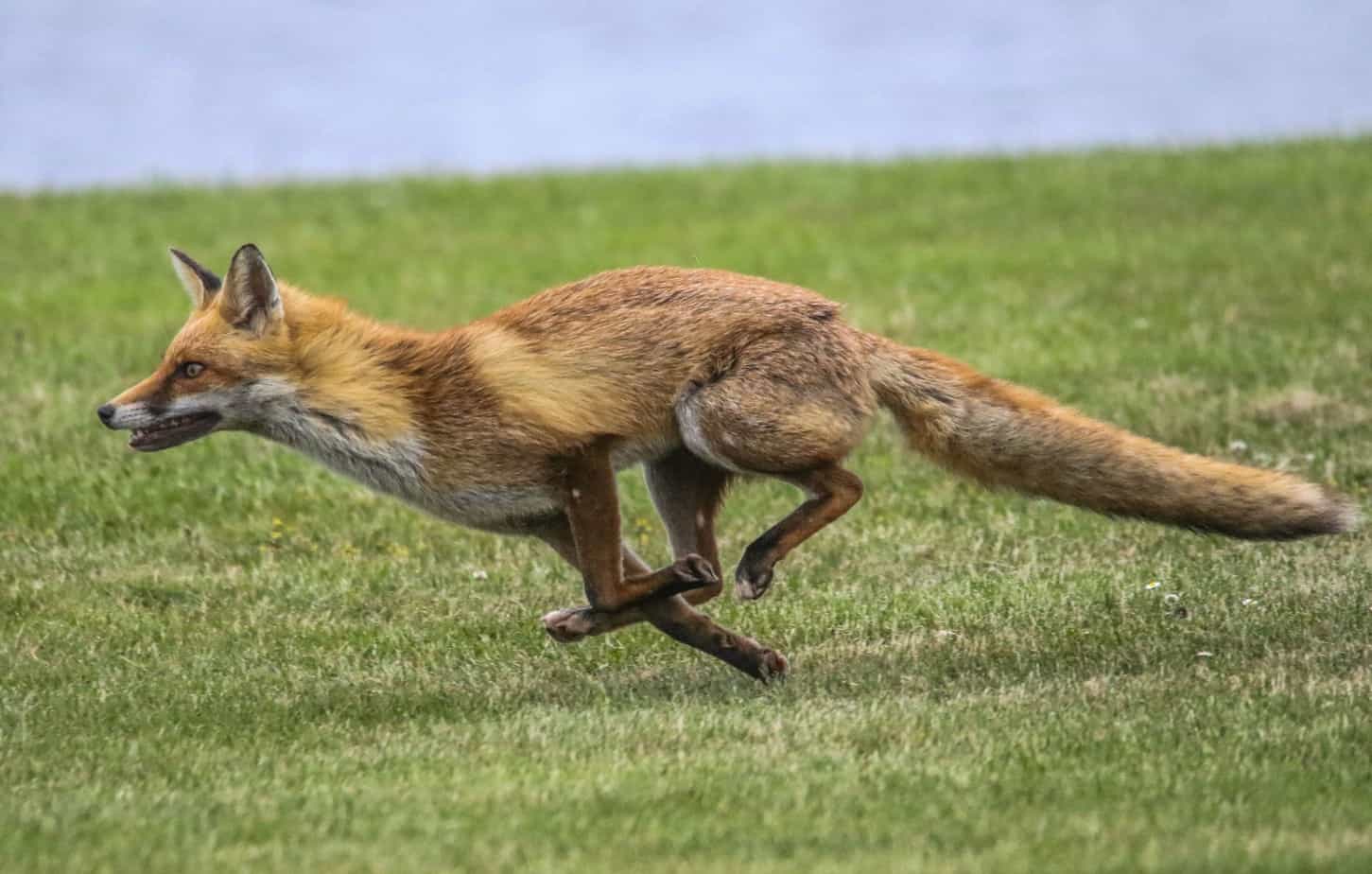Are foxes nocturnal only? Foxes are often depicted as night creatures, sneaking around under cover of darkness in search of prey.
But are foxes only active at night? Well, do not bet your chickens and ducks on it!
In this article, we’ll take a closer look at the natural history of foxes and examine the scientific evidence for and against the idea that they are strictly nocturnal animals. We’ll also explore human activity’s role in shaping fox behavior and consider the implications of our findings for the conservation and coexistence of these fascinating creatures.
So whether you’re a fox enthusiast or just curious about their sleeping habits, this article will pique your interest and shed some light on the mysterious world of foxes.

What are and why are foxes nocturnal?
Foxes are sly, swift-footed hunters that thrive in a wide variety of habitats – from the wilderness to urban sprawls. There is an abundance of species; but if you’re looking for one fox in particular, pay attention for the red fox: its cunning and brainpower have made it one of the most widespread predators on our planet!
Foxes tend to be opportunistic omnivores, consuming both plants and animals. Depending on their environment and the availability of food sources, foxes may feast upon small mammals like rodents or rabbits; scavenge for leftovers; or snack on fruits and berries. They have also been known to munch on insects, reptiles, as well as birds – taking advantage of any resources available!
Foxes have a number of physical advantages that enable them to survive in the wild. To begin with, they possess long and thick tails which give them extra balance as well as insulation when temperatures drop. Moreover, their paws are enriched with retractable claws for digging and climbing. Additionally, foxes boast superb eyesight and hearing – enabling them to locate prey effortlessly while also evading potential predators quickly.

When foxes might be diurnal.
Foxes are notorious for their swiftness and slyness, often being identified as night creatures. While the slumbering behavior of foxes is not completely known, there exists evidence that implies they may not be strictly nocturnal.
A review of scientific literature reveals that foxes are active all hours, depending on the season and food availability. Studies suggest they become nocturnal during winter days when resources are limited and daylight is scarce, while in summer months their activity shifts to daytime when provisions are readily available.
Foxes are known to be crepuscular, meaning that dusk and dawn are the most opportune times for them, as temperatures will be more comfortable and human activity is at a low. Yet further research has revealed foxes’ sleeping patterns can vary depending on their habitat or when food is available; thus they may not always sleep during the night time hours but instead slumber at any point of day or evening. Consequently, it’s clear that foxes have an intricate relationship with light–they know precisely when it would benefit them to move about in search of prey!

Role of light
Foxes’ crepuscular behavior, which is most visible during dawn and dusk, involves a multitude of factors. This encompasses the presence of food sources and other animals in the area, as well as cooler temperatures with less human influence. Though much about their interactions with darkness remains to be discovered, it has become evident that light plays an intricate role in fox lives.
During winter months, foxes become particularly active at night when food sources are scarce and the daylight hours have been reduced. Conversely, in summertime these cunning creatures tend to be more lively during the day due to improved access of sustenance and milder temperatures.
Light and darkness have a complicated impact on fox behavior due to multiple variables, like the season, habitat specifics, as well as presence of food sources or predators. Foxes are both prey animals and predators; hence they may be more active at night not just to avoid being seen by predators but also to capitalize on the low light levels in order secure their own prey.
Nevertheless, an examination of additional factors such as seasonality and living environment is required to understand how these two opposing forces shape fox activity patterns. Therefore, further research is needed to fully understand the role of light and darkness in fox behavior.

There is proof foxes are not just nocturnal.
It is commonplace to think of foxes as strictly nocturnal creatures, but how much truth is there to this assumption? While these animals are often associated with being active at night due to their agility and cunningness, scientific evidence on the matter remains inconclusive. Here we review both supporting arguments and counterpoints for the idea that foxes only sleep during nighttime hours: Evidence in favor of nocturnal:
- Foxes are naturally crepuscular, meaning they thrive and hunt during the twilight hours of dawn and dusk. This behavior is perhaps due to cooler temperatures in those periods – combined with the fact that there’s less human activity then allowing them to pursue their prey undisturbed.
- Of course, foxes have superior vision and hearing which assists them greatly in locating food while skirting danger even when it’s dark outside.
- In winter months especially, foxes become more active at night as daylight diminishes significantly compared to other times of year.
Evidence against nocturnal behavior:
- Foxes have been observed to be active at all times of the day and night, depending on the season and food availability.
- Foxes are opportunistic feeders and will take advantage of any available food source, regardless of the time of day.
- Foxes have been observed to be more active during the day in the summer months, when food is more abundant, and when the weather is warmer.
- The role of light and darkness in fox behavior may be influenced by the presence of predators and the need to avoid being seen.
Contrary to popular belief, foxes don’t solely operate during the night but instead have a more multilayered and multifaceted sleep cycle. Their activity can range from day to night, depending on external conditions such as climate, habitat surroundings, or food sources and predators in the area. We need additional studies to gain an even deeper insight into fox sleeping patterns and what causes them.

Are foxes nocturnal: Human urbanization
Urbanization and habitat loss can significantly affect the behavior of foxes. As urban areas expand and natural habitats are lost, foxes may be forced to adapt to new environments and find new sources of food and shelter.
Contrary to popular opinion, foxes do not just hunt in the dark of night – they have a much more complicated sleep cycle that is dependent on external factors like habitat conditions and food sources. To gain a better understanding of their sleeping habits, we need further research into what causes those patterns. By taking a closer look at these animals’ behavior, we can reap valuable insight about how our natural environment affects nocturnal creatures such as foxes.
Habitat loss can also impact fox behavior by reducing the availability of shelter and space for foxes. In addition, as natural habitats are destroyed or fragmented, foxes may be forced to compete with other animals for resources. They may be more likely to come into contact with humans.
As a whole, urbanization and destruction of fox habitats can have severe consequences on their behavior. By studying the consequence our activities have on these animals’ behaviors, we can find strategies that enable us to reduce discord and protect the natural homes of these captivating creatures.
Are foxes nocturnal:human activity on fox sleep patterns.
Human activity can also influence fox sleep patterns. While foxes are generally adaptable and can be active at any time of the day or night, the presence of humans can alter their natural sleeping habits.
Artificial lighting from street lamps and buildings in urban areas can drastically disrupt the natural light-dark cycle of foxes, causing their sleep patterns to become irregular. This is one way that humans are able to inadvertently affect the sleeping habits of foxes.
As a result, foxes may become more active during the night to avoid the bright lights and the presence of humans, or they may become inactive during the day when the lights are on.
Another way in which humans can influence fox sleep patterns is through the availability of food. Foxes are opportunistic feeders and will take advantage of any available food source, regardless of the time of day. In urban areas, foxes may have access to a broader range of food sources, such as garbage, pet food, and bird seed, which can alter their natural feeding habits and make them more active at different times of the day or night.
Overall, the influence of humans on fox sleep patterns is complex and depends on a variety of factors, such as habitat, the availability of food, and the presence of artificial lighting.
By understanding how human activity can shape fox behavior, we can find ways to minimize conflicts and preserve these fascinating animals’ natural habitats and behaviors.
Types of foxes.
Over 30 species of foxes are found throughout the world, with a wide range of sizes, colors, and behaviors. Here are some of the most well-known species of foxes:
- Red Fox: The red fox is the most widely distributed carnivore in the world, and it is found in a variety of habitats, including forests, grasslands, and urban areas. Red foxes are known for their distinctive red coat, bushy tail, and sharp senses. They are omnivorous and adaptable and are known to eat a wide range of foods, including small mammals, fruits, and insects.
- Arctic Fox: The arctic fox is found in the cold, snowy environments of the Arctic tundra. It has a thick, white coat that helps it blend in with its snowy surroundings and stay warm in freezing temperatures. Arctic foxes are primarily carnivorous and feed on a variety of small mammals, birds, and eggs.
- Fennec Fox: The fennec fox is native to the Sahara desert in North Africa and is the smallest fox species in the world. Fennec foxes have large ears that help them dissipate heat and detect prey and long, thick fur to protect them from the hot desert sun. They are omnivorous and feed on a variety of small mammals, insects, and plants.
- Grey Fox: The grey fox is native to North and South America and is known for its distinctive grey coat and black-tipped tail. Grey foxes are agile climbers, often found in wooded areas. They are omnivorous and feed on various foods, including fruits, insects, and small mammals.
- Kit Fox: The kit fox is native to the southwestern United States and Mexico desert regions. It is a small, slender fox with large ears and a sandy-colored coat. Kit foxes are primarily carnivorous, and they feed on small mammals and insects. They are adapted to survive in dry, hot environments and are known for their efficient water use.
Overall, foxes are a diverse and fascinating group of animals with a wide range of adaptations and behaviors. Therefore, understanding these animals’ natural history and biology is crucial for their conservation and finding ways to coexist with them.
Fox habitat.
Foxes are found in a wide range of habitats around the world, including forests, grasslands, deserts, and urban areas. The specific habitat of a fox depends on the species and the availability of food, water, and shelter.
For example, arctic foxes are found in the cold, snowy environments of the Arctic tundra, while fennec foxes are native to the hot, dry Sahara desert. However, foxes are generally adaptable animals and can survive in various environments as long as they have access to the resources they need.
Foxes are omnivorous, which means they eat both plants and animals. Their diet can vary depending on their habitat and the availability of food sources. In some areas, foxes may mostly eat small mammals such as rodents and rabbits, while in others, they may scavenge for food or feed on fruits and berries.
Foxes are also known to eat insects, reptiles, and birds and will opportunistically take advantage of any available food source.
In addition to their natural diet, foxes are also known to scavenge for food in urban areas, which can sometimes lead to conflicts with humans.
To prevent these conflicts, it is crucial for people to secure their trash and not intentionally feed foxes. This helps ensure that foxes can find their natural food sources and that they do not become reliant on human-provided food.
Why foxes survive in the wild.
Foxes are well-adapted to survive in a wide range of environments and conditions. Here are some of the physical adaptations that help foxes survive in their environment:
- Retractable claws: Foxes have retractable claws on their paws, which allow them to dig and climb when necessary. These claws are also used for hunting and defense.
- Bushy tail: Foxes have long, bushy tails that provide balance and insulation. The tail helps foxes maintain their balance while running and jumping, and it also helps keep them warm in cold environments.
- Sharp senses: Foxes have excellent eyesight and hearing, which helps them locate prey and avoid predators. They are also known for their keen sense of smell, which they use to find food and communicate with other foxes.
- Thick fur: Many species of foxes have thick fur coats that help protect them from the elements and regulate their body temperature. For example, arctic foxes have thick, white fur that helps them blend in with their snowy surroundings and stay warm in freezing temperatures.
Overall, the physical adaptations of foxes are essential for their survival and reproduction in the wild. By understanding these adaptations, we can better understand the natural history and behavior of foxes and find ways to coexist with these fascinating animals.
The nocturnal fox: Recap.
Famed for their cunning, foxes are remarkable mammals renowned for their swift hunting styles and sharp senses.
These versatile creatures can be found in a variety of habitats all over the world, where they enjoy eating everything from insects to small mammals and fruits. Equipped with retractable claws, a bushy tail, as well as heightened intelligence – it’s no surprise that these nimble animals have been able to adapt so successfully!
Contrary to popular belief, foxes may follow a more flexible sleep schedule than expected. Studies have found that these furry creatures can be active day and night depending on the time of year and availability of food. Thus, it is evident that foxes do not genuinely conform to a strict nocturnal pattern as previously assumed.
However, foxes are known to be crepuscular, which means they are most active during the twilight hours of dawn and dusk. The role of light and darkness in fox behavior is complex and depends on various factors such as season, habitat, and the availability of food and predators.
Human activity can also have an impact on fox behavior. For example, urbanization and habitat loss can alter the availability of food and shelter for foxes, and artificial lighting can disrupt their natural light-dark cycle.
By understanding the natural history and behavior of foxes, we can find ways to coexist with these fascinating animals and preserve their habitats.

